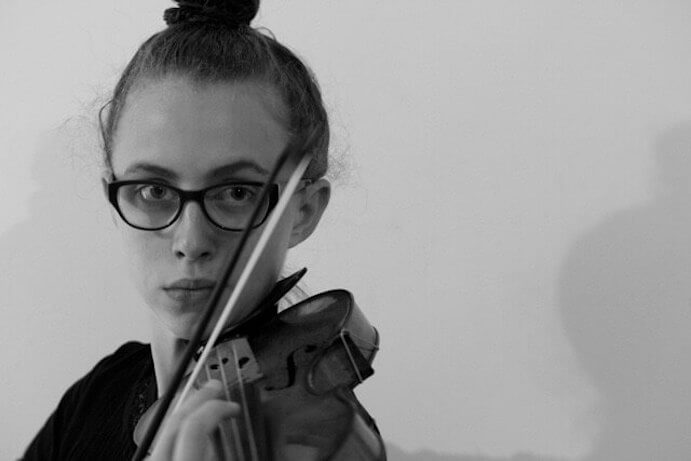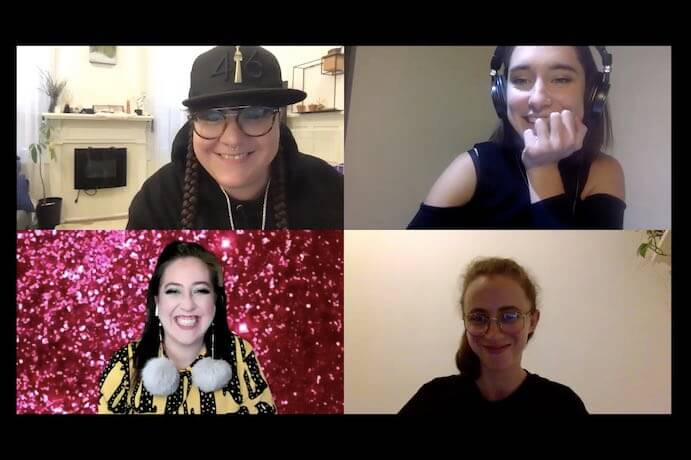On October 18, 2020, audiences across multiple time zones gathered to watch cellist Isidora Nojkovic and violinist Aliayta Foon-Dancoes’ trans-continental program, “Orbit.” Via Zoom, Nojkovic and Foon-Dancoes presented new works designed for this digitally mediated moment, written by composers Cris Derksen and Olivia Shortt. Despite the concert’s brevity, both pieces packed a mind-bending punch, questioning whether synchronicity always means “sounding together.”
From the outset, Foon-Dancoes and Nojkovic foregrounded the importance of close collaboration, especially in light of a sizeable geographical gap. With Foon-Dancoes based in London and Nojkovic in Vancouver (not to mention their composer collaborators in other parts of Canada), the logistics of both the rehearsal process and concert would have to be altered…how could they make music by working with their displacement, rather than against it? As the duo worked together with Derksen and Shortt experiencing dozens of variations on the Zoom concert as audience members, the group eventually decided that their commissions would be best presented by pre-recording them, leaving plenty of space for a live, interactive component during the event itself.

Isidora Nojkovic–Photo by Jasmine Sallay Carrington
Cris Derksen’s Latency was designed with Zoom as both inspiration and model. Weary of waging war with bandwidth and its inevitable technical difficulty, Derksen simulates latency, creating its characteristic stutters and glitches using precisely calculated delay. Derksen engineered an environment in which Foon-Dancoes and Nojkovic could use the playback as a metronome. “It took quite a bit of practice,” Nojkovic admitted in her introduction. “It was like playing chamber music with yourself.”
Latency opens with slow-motion counterpoint, sonorous and undulating. Derksen cleverly obscures the rhythmic force of the delay until a dramatic shift to pizzicato brings the echoes into the foreground. The duo’s attention to timing was meticulous, alternating between staying with the groove, and laying back into their echoes, blurring their own articulations with hypnotically phased interjections. Although distance forced the duo to record their parts separately, each player’s microphone and ambient space produced a unique timbral signature. Their interactions were fascinating; with every collision of Foon-Dancoes and Nojkovic’s individual lines, their electronified instruments enacted a playful tug-of-war with the ear, bouncing from strident and spacious cello, to crisp violin, and back.

Aliayta Foon-Dancoes–Photo by Elisa Mitrofan
The premiere of bagaskaadagaazii by Olivia Short began not with the piece itself, but with its instructions. Shortt wanted to experiment with an aural score, one where written or notated instructions are replaced with a recording, transmitted to the performers via headphones. For Foon-Dancoes and Nojkovic, the aural score was a direct line into bagaskaadagaazii’s soundworld, blending elements of electronic music with verbal directions and their own pre-recorded clips. With every performance, the duo recreates the work anew through interpretive strategies that range from mimicry to musical Rorschach, working though chains of timbral or gestural association. Both the score and their realization centered musical imagery of water—the title of the work roughly translating to, “she/he/they wades and splashes in the water.”
But here’s the catch: the audience couldn’t hear the score, and the performers couldn’t hear one another. “I turned the volume up to the point where I couldn’t even hear my own playing!” Nojkovic remarked. The duo connected through points of reference: they listened and reacted to the aural score, but they did so individually, with no recourse to one another. It wasn’t until the final cut of the performance–using excerpts chosen by the performers–that the separate takes of violin and cello sounded together.
Isidora Nojkovic and Aliayta Foon-Dancoes’ “Orbit”–Screenshot courtesy of the artists
Despite what might seem like such a tenuous connection in the production process, the concrete realization felt solid and grounded. Splashy sibilance pervaded all parts of the piece from scratchy bow pulls to vocalized hisses, enveloping the listener in Shortt’s watery soundworld. In such a sonically dense environment, the inclusion of the performers’ videos (even showing multiple takes from the same player) allowed the listener to parse and isolate individual streams of sound, a feat that would have proven impossible in a live performance.
“Orbit” was focused and succinct, clocking in at just under half an hour. With a Q&A following the program and friendly banter interspersed between the pieces, this concert seemed to fly in the face of pretense. And although digital concerts so often emphasize the global connections they enable, most striking about “Orbit” was the feeling it conjured of locality and specificity. It wasn’t local in a literal sense; no two participants occupied the same space. But it was local in that it pulled together a circumscribed community of supporters, rooted in first-degree connections, friendship, and curiosity.
I CARE IF YOU LISTEN is a program of the American Composers Forum, funded with generous donor and institutional support. A gift to ACF helps support the work of ICIYL. Editorial decisions are made at the sole discretion of the editor-in-chief. For more on ACF, visit the “At ACF” section or composersforum.org.

